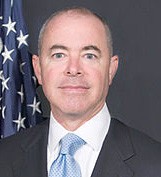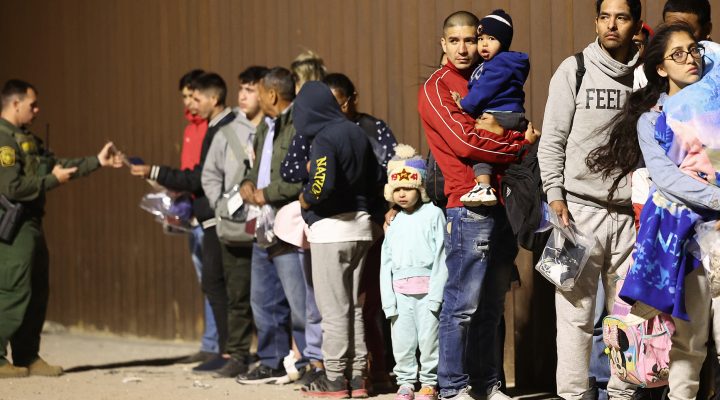The Biden administration said its new travel ban on asylum seekers will expand the number of legal pathways for migrants seeking refuge at the U.S. southern border, but immigration advocates held a virtual press conference May 10 to say they aren’t buying it.

Katrina Eiland
“Seeking asylum at the border is a lawful pathway, and so it’s a misnomer to refer to these other supposed alternatives as lawful pathways as though the normal process of entering the country and requesting asylum is no longer a lawful pathway. That’s just incorrect,” said Katrina Eiland, managing attorney with the American Civil Liberties Union Immigrants’ Rights Project.
Yet that is how Homeland Security Secretary Alejandro Mayorkas and the White House are describing the new rule that will be enacted at 11:59 p.m. May 11, the moment Title 42 expires.
“Our overall approach is to build lawful pathways for people to come to the United States and to impose tougher consequences on those who choose not to use those pathways,” Mayorkas said during a May 10 press briefing.

Alejandro Mayorkas
Those consequences include disqualifying refugees from asylum eligibility and returning them to their countries of origin, he said. “We are taking this approach within the constraints of a broken immigration system that Congress has not fixed for more than two decades.”
The new measure borrows from two Trump-era travel bans — both struck down by federal courts — that required refugees to first seek and be denied asylum in a third country before seeking refuge in the U.S. The rule also offers the option of applying for a meeting with American immigration officials by using the CBP One mobile app, which has been found to be full of glitches and forces those fleeing harm to wait weeks or months in Mexico for their appointments.
The effect of the rule will be similar to that of Title 42, a federal health code provision used by the Trump administration to quickly return asylum seekers to their home countries or Mexico.
“It will strand people indefinitely in Northern Mexico because of what we know to be very limited caps on the number of CBP One appointments that are going to be available daily, border wide,” Eiland said. “This will place people in an impossible position to decide whether to try to cross the border between ports of entry or to arrive at a port of entry without an appointment, in both cases risking being ineligible for asylum or waiting in dangerous conditions where their lives could be in danger.”

Bilal Askaryar
The new Biden plan continues the assault on asylum seekers previously waged through Title 42, said Bilal Askaryar, interim manager for the #WelcomeWithDignity campaign, which organized the virtual event.
“The human and legal right to seek asylum is under attack and it has been under attack for the past three years. And instead of using this opportunity as an inflection point to restore our nation’s commitment to asylum seekers, to refugees seeking protection at our doorstep, President Biden and his administration have doubled down on failed policies like deterrence and are doubling down on enforcement,” Askaryar said.
“People seeking protection at our border are not a crisis or the cause of a crisis.”
It’s inappropriate to place the blame for U.S. immigration challenges on immigrants, he added. “People seeking protection at our border are not a crisis or the cause of a crisis. People seeking protection at our borders are asking us to live up to the nation they believe we are: a beacon of safety and opportunity like we have been for so many families, including mine.”

Patrick Giuliani
Patrick Giuliani, policy analyst with the Hope Border Institute, described the new asylum ban as an effort to stifle asylum.
“This is trying to make the system as complicated as possible to navigate for the individual. The policy also does nothing to address root causes of migration. In many ways, it will just frustrate people even more.”
Among those who will benefit from the policy are human smugglers and cartels, he said. “We know there are bad actors who will take advantage of people who are in vulnerable positions because of how complicated the legal system is here in the U.S. It has happened for years. It will continue to happen.”
Implementation will not reduce the nation’s immigration challenges, said Melissa Crow, director of litigation for the Center for Gender and Refugee Studies. “This rule will only jeopardize the lives of people seeking safety and create even more chaos and suffering at our southern border. And as the administration well knows, it’s also blatantly illegal.”
“The right to seek our asylum at our southern border is enshrined in both U.S. and international law.”
What is lawful is asylum, she said. “The right to seek asylum at our southern border is enshrined in both U.S. and international law, and that’s regardless of how an individual comes to or enters this country.”

Melissa Crow
Crow and Eiland added that legal action will be taken to stop enforcement of the rule soon after it takes effect.
“The reality is that asylum is many people’s last, best chance at finding safety, and it’s designed for people fleeing imminent threats to their lives who can’t avail themselves of other pathways, who don’t have the luxury of waiting for an advance appointment and who are not in a position to wait for an application to be adjudicated in a country that isn’t safe.”
Related articles:
Majorities of all Americans want something Congress refuses to do: Meaningful immigration reform now
Title 42, congregations and the sojourner | Opinion by Sean Powell
What happens after Title 42? | Opinion by Elket Rodriguez


